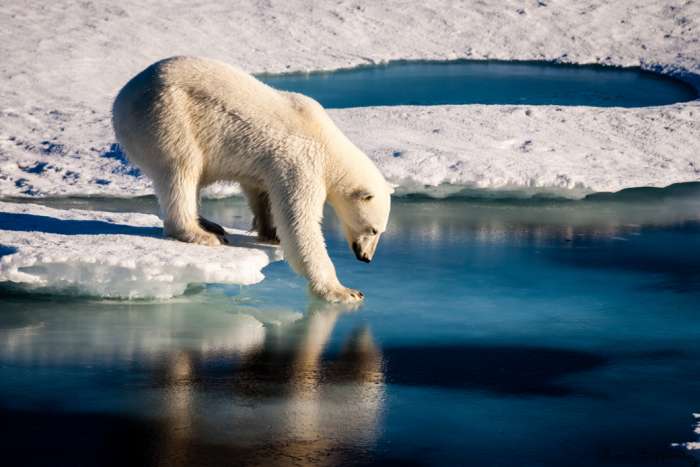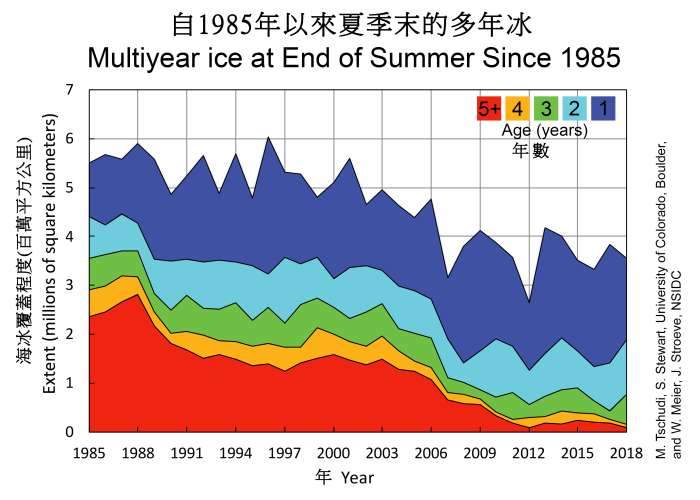"Last Ice Area" Breaks Up for First Time on Record
14 December 2018
Breaking news of the Arctic just cannot stop in recent years. For example, average Arctic land surface temperature in 2017 was the second highest on record. Arctic sea ice extents for January and February 2018 were both record lows for the respective month. Furthermore, the "last ice area" of northern Greenland was broken up for the first time this year.
Very old and thick sea ice exists along the shores of northern Greenland. Sea ice over the region normally persists in summer. Scientists believed that this region would be the "last ice area", i.e. the last area where sea ice could still be found in the Northern Hemisphere under global warming. However, the anomalous warmth in northern Greenland this February and August caused the "last ice area" to open up twice1. According to media reports, the opening up of the "last ice area" in February 2018 was the first time on record (Figure 1)2 while the second opening up in August was highly unusual. Some experts described the situation as "scary", which prompted scientists to re-examine which areas of Arctic are capable of withstanding the effects of climate change.
The size of reflective surface of sea ice is one of the critical factors that affect the Earth's temperature. Reduction of sea ice weakens the Earth's ability to reflect sunlight, enabling the Earth to absorb more heat which, in turn, promotes further melting of ice and snow in a vicious circle. Studies pointed out that accelerated warming in the Arctic might have profound impacts on mid-latitude weather, causing longer droughts or heat waves over the region3. On the other hand, the progressive loss of sea ice will very likely cause the global polar bear population to decline by more than 30% over the next 40 years (Figure 2). The Arctic sea ice extent usually reaches its annual minimum around mid-September. In the last 40 years, the monthly Arctic sea ice extent in September exhibits a significant decreasing trend (Figure 3). In addition, very old sea ice in the Arctic has nearly vanished (region in red in Figure 4). If the trend persists, the Arctic Ocean will be ice-free in summer by mid-21st century.
Sea ice plays an important role in maintaining Earth's temperature. Present-day global mean temperature was approximately 1oC above pre-industrial levels, leading to sea level rise, melting of sea ice and more extreme weather. If the sea ice continues to decrease and the climate continues to warm, the polar bear will not be the only victim.
F. C. Sham

Figure 1 Sea ice cover near northern Greenland opened up on 26 February 2018 (red ellipse).
(Photo courtesy: US National Snow and Ice Data Center, NSIDC)

Figure 2 All polar bears across the Arctic face shorter sea ice season.
(Photo courtesy: Mario Hoppmann)

Figure 3 Significant decrease in September Arctic sea ice extent
(Source: NSIDC)

Figure 4 Very old sea ice in the Arctic has nearly vanished.
(Source: NSIDC)
References:
1.Unusually warm winter breaks up sea ice in the Arctic
https://climate.nasa.gov/news/2690/unusually-warm-winter-breaks-up-sea-ice-in-the-arctic/
2.Thick Arctic sea ice off Greenland breaks up for first time on record
https://www.scmp.com/news/world/article/2160699/thick-arctic-sea-ice-greenland-breaks-first-time-record
3.The influence of Arctic amplification on mid-latitude summer circulation
https://www.pik-potsdam.de/news/press-releases/nice-sunny-days-can-grow-into-heat-waves-2013-and-wildfires-summer-weather-is-stalling
Very old and thick sea ice exists along the shores of northern Greenland. Sea ice over the region normally persists in summer. Scientists believed that this region would be the "last ice area", i.e. the last area where sea ice could still be found in the Northern Hemisphere under global warming. However, the anomalous warmth in northern Greenland this February and August caused the "last ice area" to open up twice1. According to media reports, the opening up of the "last ice area" in February 2018 was the first time on record (Figure 1)2 while the second opening up in August was highly unusual. Some experts described the situation as "scary", which prompted scientists to re-examine which areas of Arctic are capable of withstanding the effects of climate change.
The size of reflective surface of sea ice is one of the critical factors that affect the Earth's temperature. Reduction of sea ice weakens the Earth's ability to reflect sunlight, enabling the Earth to absorb more heat which, in turn, promotes further melting of ice and snow in a vicious circle. Studies pointed out that accelerated warming in the Arctic might have profound impacts on mid-latitude weather, causing longer droughts or heat waves over the region3. On the other hand, the progressive loss of sea ice will very likely cause the global polar bear population to decline by more than 30% over the next 40 years (Figure 2). The Arctic sea ice extent usually reaches its annual minimum around mid-September. In the last 40 years, the monthly Arctic sea ice extent in September exhibits a significant decreasing trend (Figure 3). In addition, very old sea ice in the Arctic has nearly vanished (region in red in Figure 4). If the trend persists, the Arctic Ocean will be ice-free in summer by mid-21st century.
Sea ice plays an important role in maintaining Earth's temperature. Present-day global mean temperature was approximately 1oC above pre-industrial levels, leading to sea level rise, melting of sea ice and more extreme weather. If the sea ice continues to decrease and the climate continues to warm, the polar bear will not be the only victim.
F. C. Sham

Figure 1 Sea ice cover near northern Greenland opened up on 26 February 2018 (red ellipse).
(Photo courtesy: US National Snow and Ice Data Center, NSIDC)

Figure 2 All polar bears across the Arctic face shorter sea ice season.
(Photo courtesy: Mario Hoppmann)

Figure 3 Significant decrease in September Arctic sea ice extent
(Source: NSIDC)

Figure 4 Very old sea ice in the Arctic has nearly vanished.
(Source: NSIDC)
References:
1.Unusually warm winter breaks up sea ice in the Arctic
https://climate.nasa.gov/news/2690/unusually-warm-winter-breaks-up-sea-ice-in-the-arctic/
2.Thick Arctic sea ice off Greenland breaks up for first time on record
https://www.scmp.com/news/world/article/2160699/thick-arctic-sea-ice-greenland-breaks-first-time-record
3.The influence of Arctic amplification on mid-latitude summer circulation
https://www.pik-potsdam.de/news/press-releases/nice-sunny-days-can-grow-into-heat-waves-2013-and-wildfires-summer-weather-is-stalling